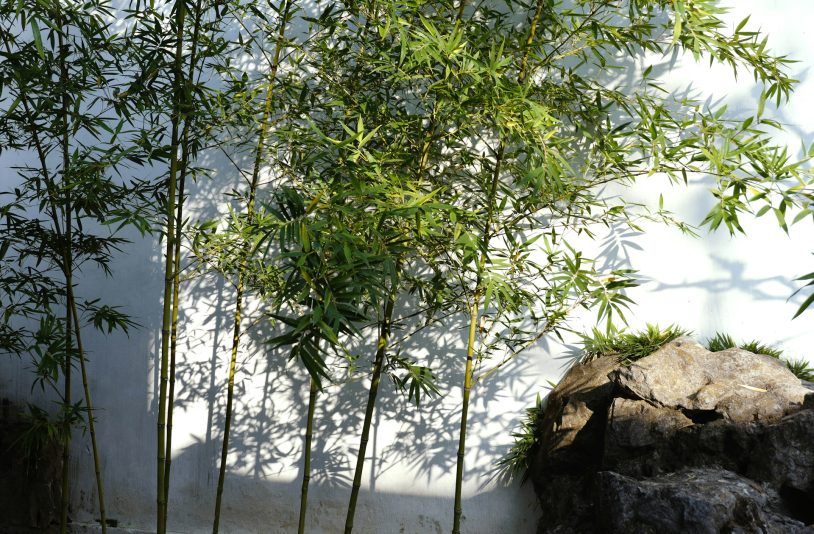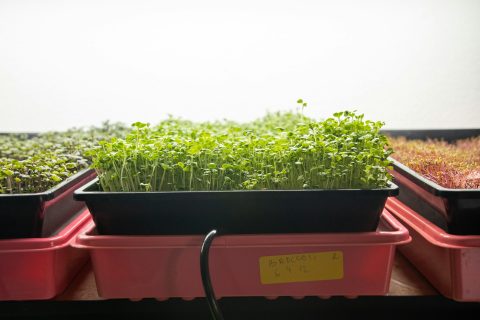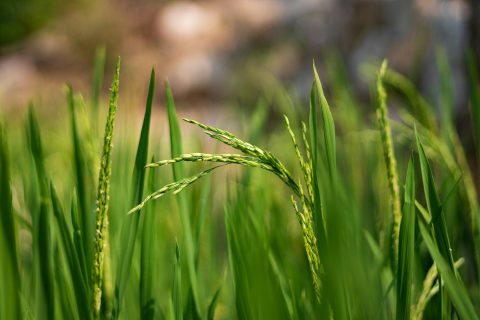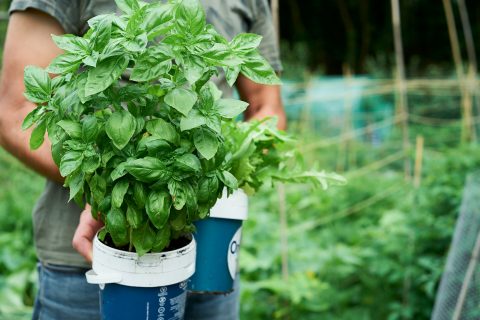
Bamboo is a plant that is both beautiful and incredibly useful. From creating a natural privacy barrier to bringing a bit of the tropics home or trying something different, bamboo can meet your needs.
The best part is that it requires minimal maintenance once it’s established. However, before you start planting, it’s important to understand a few key factors, such as which type of bamboo to select, how to grow it correctly, and how to prevent it from spreading uncontrollably (yes, it can be pretty invasive!).
In this guide, we’ll walk you through everything you need to know, step by step. Let’s get your bamboo-growing journey started!
Jump to Section [Hide]
- Understanding Bamboo Basics
- Choosing the Right Bamboo Species
- Preparing for Bamboo Planting
- How to Plant Bamboo Step-by-Step
- Caring for Bamboo After Planting
- How to Control Bamboo Growth
- Propagating Bamboo
- Dealing with Common Bamboo Issues
- Growing Bamboo in Containers
- Seasonal Bamboo Care Tips
- Creative Uses for Bamboo in the Garden
Understanding Bamboo Basics
Clumping vs. Running Bamboo: Key Differences
Clumping bamboo grows in tight, non-invasive clusters, making it ideal for small gardens. Types like Bambusa and Fargesia spread slowly, about 1 to 2 feet per year. Their rhizomes grow upward instead of outward, so they won’t take over your yard or invade neighbors’ spaces.
Running bamboo spreads aggressively through long rhizomes underground. Examples include Phyllostachys and Pleioblastus. These can grow up to 5 feet yearly, making barriers essential.
Use a barrier at least 2 to 4 feet deep with a 3-inch extension above the soil to keep it contained. Without control, it can quickly dominate nearby areas.
Bamboo Growth Habits and Life Cycle
Bamboo has a unique growth pattern. Its rhizomes spread quickly, especially during spring and early summer. Shoots can grow several inches daily under the right conditions. Bamboo prefers moist, well-drained soil with plenty of sunlight to thrive.
Flowering is rare but important in bamboo’s life cycle. If you spot flowering shoots, cut them immediately to prevent energy drain. Sometimes, the whole plant flowers. In that case, feed it organic fertilizers and water deeply before cutting back in spring for rejuvenation.
Divide healthy clumps every few years using a saw to maintain strong growth and prevent overcrowding.
Common Myths and Misconceptions
Lucky bamboo is not an actual bamboo. It’s actually Dracaena sanderiana, a fast-growing houseplant native to Africa. Many people confuse it with real bamboo because of its name and appearance, but it belongs to a completely different plant family.
Some think lucky bamboo is safe for pets. This is false. It’s toxic to cats and dogs if eaten. Another myth claims that lucky bamboo thrives better in water alone; while it can survive 1–2 years this way, planting it in soil can make it last several years longer.
Choosing the Right Bamboo Species
Pick a bamboo species that fits your weather and needs. Some grow fast, while others stay neat and compact—choose wisely!
Climate Compatibility
Bamboo grows best in tropical and subtropical climates. These areas have warm temperatures and high humidity. Tropical bamboo thrives in USDA zones 7–10. Species like Bambusa multiplex Alphonse Karr and Phyllostachys nigra are perfect choices.
Cooler climates, like zones 5–6, suit varieties such as Fargesia dracocephala Rufa.
Most bamboo needs at least 8 hours of sunlight every day. Tropical types may need shade during intense afternoon heat. In frost-prone areas, pick partial shade to protect the plant.
For the best results, match your bamboo species to your local climate conditions.
Purpose-Driven Selection
Pick bamboo based on your goals. For privacy screens, choose clumping bamboo like Bambusa multiplex. It’s non-invasive and grows in tight clusters. If you need fast growth for shade or windbreaks, running bamboo such as Phyllostachys aurea may be better suited.
Keep in mind, runners spread quickly and require rhizome barriers.
For construction purposes, species like Guadua angustifolia are strong and durable. Test their structural suitability before using them. Interested in boosting soil fertility? Companion crops like legumes can grow alongside bamboo in an agroforestry system.
They enrich the soil while creating a sustainable setup that benefits both plants and the environment. Always match the bamboo type to your climate and purpose for the best results!
Popular Bamboo Varieties
Running bamboos like Phyllostachys and Arundinaria grow fast and spread widely. These types are great if you want a dense screen or privacy fence. Sasa works well for ground cover, while Pseudosasa adds height to small gardens.
If you prefer non-spreading options, clump-forming bamboo such as Bambusa and Fargesia is ideal. They grow in compact clusters without taking over your yard. Lucky bamboo (Dracaena sanderiana) is another option for indoors, reaching up to 15 feet tall with proper care!
Preparing for Bamboo Planting
Pick the right season, find a sunny spot, and prep the soil well—setting the stage for healthy bamboo growth!
Best Time of Year to Plant Bamboo
In tropical and subtropical areas, plant bamboo at the start of the rainy season. The soil’s natural moisture helps roots settle quickly. In temperate climates, aim for early autumn before winter hits.
This timing allows bamboo rhizomes to establish during cooler weather.
For seeds, spring is best for quick growth as the days warm. Transplant seedlings three to four months after they sprout when their rhizome forms fully. Following this schedule supports healthy and steady bamboo development.
Choosing the Ideal Location
Pick a spot with plenty of sunlight, at least 8 hours daily. Tropical bamboo types may prefer shade during hot midday hours. If your area gets frost in winter, partial shade helps protect the plants.
Keep them out of strong winds by using trees, fences, or hedges to shield their shallow roots.
Place bamboo near water sources, such as ponds or streams, for better growth. Also, think about future harvesting needs. Being close to transportation routes makes it easier and faster to move harvested bamboo.
Choose a space that allows for easy maintenance and aligns with your long-term plans for the plant’s use.
Preparing the Soil
Check the soil’s pH first. Bamboo prefers slightly acidic soil, between 5.5 and 6.5. If the pH is too low, add agricultural lime. For alkaline soil above 6.5, mix in coconut coir or composted material to lower it.
Fertile, well-drained loam soil works best. Avoid rocky, soggy, or hard-packed soil types.
Make loam by combining 5 parts topsoil, 2 parts sand, 2 parts silt, and 1 part clay. Enrich the area with organic compost or coco peat to improve nutrient levels. This improves water retention and drainage.
Healthy soil sets a solid base for bamboo growth.
How to Plant Bamboo Step-by-Step
Planting bamboo is simple if you follow a few key steps. With the proper care at the start, your bamboo will thrive for years.
Step 1: Acquiring Healthy Plants
Choose bamboo as cuttings or seedlings instead of seeds for better success. Seeds often grow more slowly and may not thrive. Look for plants at specialist nurseries, sustainable gardening platforms, or horticultural groups.
Inspect the roots before buying. Healthy bamboo should have fresh green leaves and firm stems. Avoid any with yellowing leaves, weak sprouts, or pests like rust on the foliage.
Step 2: Digging and Preparing the Planting Hole
Dig a hole that is twice as wide as the bamboo root ball. This gives the roots enough room to spread and grow properly. Make sure the hole is deep enough so the bamboo sits slightly below the soil surface.
This helps the plant stay stable and retain moisture.
If you are planting running bamboo, space the holes 3 to 5 feet apart. For clumping bamboo, use 1 to 2 feet of spacing instead. Use rich, well-draining soil to give the roots a strong base.
Organic mulches can be added later, but the hole should be clean and ready for planting first.
Step 3: Proper Spacing and Planting Depth
Space running bamboo 3 to 5 feet apart. For clumping bamboo, leave 1 to 2 feet between plants. This spacing helps roots grow properly and prevents crowding.
Keep the root ball covered with 1 inch of soil. Do not bury it too deeply, as this can harm growth. Ensure the planting hole is wide enough for the roots. Keep the soil firm around the plant to support it.
Step 4: Mulching and First Watering
Spread a layer of mulch around your bamboo. Use grass clippings, compost, or hay to cover the soil. This keeps moisture in and stops weeds from growing near your plant.
Water the bamboo deeply right after planting. Soak the soil to help the roots settle. For new shoots or bamboo seeds, water every day until they grow strong.
Caring for Bamboo After Planting
Keep your bamboo thriving with proper watering, feeding, and pruning—small efforts now mean lush, healthy growth later!
1. Watering Guidelines
Water the bamboo daily after planting. Newly established plants need constant moisture to grow strong. In hot or windy weather, water 3–4 times a week. Mature bamboo requires less frequent care, about 2–3 times weekly.
For container-grown plants, increase your watering routine during the summer months when the soil dries out fast. Dry roots can lead to poor growth or leave the plant stressed and yellowing.
Use mulch around the base to retain moisture longer between watering sessions.
2. Fertilizing Bamboo
Feed the bamboo with a high-nitrogen fertilizer twice a year, in spring and summer. In areas with poor soil, apply a general-purpose fertilizer during spring to boost growth. Container bamboo needs extra care.
Use a liquid feed monthly from March to October to keep it thriving.
Leave fallen bamboo leaves on the ground. They naturally add silica, which strengthens bamboo. Silica-rich soil helps maintain healthy shoots and vibrant leaves. Always follow these steps for stronger, greener bamboo.
3. Supporting Bamboo Growth
Mulch your bamboo with organic materials like hay or compost. This boosts soil health and keeps moisture locked in. Healthy soil and steady watering are crucial for strong bamboo growth.
Use potting compost for added nutrients if needed.
Prune lower leaves to show off the colorful canes. This also helps the bamboo grow upright and stay neat. Remove weak or crowded stems to let light and air in, which supports better growth.
Regular care keeps your bamboo vibrant and thriving.
4. Pruning and Thinning
Cut weak or dead canes in spring to keep your bamboo healthy. Trim the tops of taller canes to control height and make the plant bushier. This helps it grow strong and neat.
Remove older branches each year to stop overcrowding. Thin out dense clumps as needed for better air circulation and light. This keeps pests away, avoids diseases, and boosts plant health.
How to Control Bamboo Growth
Bamboo can spread fast if left unchecked. Use simple tools and techniques to keep it in place.
Installing Rhizome Barriers
Use barriers to manage invasive bamboo. Install them 60–120 cm (2–4 ft) deep for running species. Choose strong materials like plastic, metal, or concrete. Barriers should be at least 2.5 m (8 ft) wide for large varieties.
Overlap the barrier edges by 30 cm (1 ft) to prevent gaps. Extend it 7.5 cm (3 in) above the soil to stop rhizomes from escaping over the top. Check regularly for shoots trying to climb or sneak under; trim these promptly for control!
Maintenance Practices
Inspect rhizome barriers regularly to stop bamboo from spreading. Check for any damage or gaps, and repair them quickly. Dig out shoots that escape the barrier before they grow too large.
This keeps your bamboo contained and tidy.
Prune lower foliage and remove unwanted canes to control overcrowding. Thin the plants as needed for proper air circulation and shape management. Regular upkeep also helps prevent pests or diseases from hiding in dense growth.
Containing or Removing Unwanted Growth
Dig out bamboo shoots that grow outside their boundaries. Use sharp shears to cut and remove rhizomes. Check for any escaping growth every few weeks. This helps stop bamboo from spreading.
Install rhizome barriers at least 3-4 feet deep. These barriers block underground rhizomes from spreading further. Monitor regularly, and trim shoots near the edges to keep the bamboo contained.
Propagating Bamboo
Propagating bamboo can be fun—you can divide clumps, cut rhizomes, or even grow it from seeds to expand your garden.
Division of Clumps
Divide bamboo clumps in mid-spring. This is the best time to use young rhizomes for propagation. Use a sharp spade or saw to separate sections of the root mass. Mature clumps can be tough so that you may need help from another person.
Replant divided rhizomes and canes right away into prepared soil. Water them well after planting to help them settle and grow strong roots quickly. Keep spacing in mind when planting multiple divisions to prevent overcrowding later.
Rhizome Cuttings Method
Take rhizome cuttings in early spring for the best results. Use healthy bamboo rhizomes with visible buds or roots. Place them in gritty compost to encourage growth and drainage. Make sure the compost stays moist but not soggy.
Keep the cuttings warm and humid to help roots develop faster. You can cover them lightly with plastic or place them in a greenhouse for consistent warmth. Roots usually form within 30 days under good conditions, making this method quick and effective for propagating bamboo!
Growing from Seeds
Clean and dry bamboo seeds for 1–2 hours. Soak them in water for 6–12 hours. Use a planting mix of 8 parts topsoil, 1 part ash, and 1 part husks or chips. Sow the seeds 1–2 inches deep in the soil.
Water lightly to keep the soil moist but not soggy.
Seedlings take 10–25 days to sprout. Wait 3–4 months for rhizomes to form before transplanting. Use organic gardening techniques to encourage healthy growth. Keep the area free of pests by applying insecticidal soap if needed.
Timing and Tools
Propagate bamboo in mid-spring if dividing clumps. Use early spring for rhizome cuttings. This helps ensure strong growth and healthy plants. For seed propagation, aim for temperatures between 65–70°F.
Keep the area humid to support germination.
Use proper tools, such as saws, for division, and containers for cuttings. Get a good potting mix when growing indoors or transplanting outdoors. These tools make the planting process easier and more effective.
Dealing with Common Bamboo Issues
Bamboo can be affected by pests, diseases, and stress, which can affect its growth. Learn to spot problems early and keep your plants healthy.
Common Pests
Scale insects, red spider mites, aphids, and mealybugs often attack bamboo. These pests suck sap from the plant, weakening it over time. You might notice yellowing leaves or sticky residue on stems as signs of infestation.
To treat infestations, spray neem oil or soapy water directly on affected areas. Always quarantine new plants before introducing them to your garden. This step helps prevent pest spread and keeps your bamboo healthy.
Fungal and Bacterial Diseases
Bamboo is often affected by rust and root rot, especially in poorly drained soil. Keep the soil well-drained to stop these diseases from spreading. If you notice rust-colored spots or wilting growth, act quickly.
Using fungicides can help tackle fungal problems.
Algae may grow in water-filled pots or containers where bamboo is planted. Clean these regularly with mild detergent to prevent buildup. Good air circulation around your bamboo plants also helps reduce disease risk and keeps them healthy.
Yellowing Leaves
Yellowing leaves often mean too much sunlight or fertilizer. Check if your bamboo gets too much direct sun during the hottest part of the day. Move it to filtered light if needed. Over-fertilizing can also cause problems.
Use a balanced fertilizer sparingly and avoid feeding more than once a month.
Bad water quality might also be the issue. Chlorine in tap water damages leaves. Use rainwater or let tap water sit out for 24 hours before watering. Keep the soil slightly moist but not soggy.
Dry soil can stress the plant and add to the yellowing.
Signs of Stress
Bamboo can show stress in several ways. Mushy stalks often mean rot. Remove these stalks right away, clean the pot or container, and refresh the water or soil. Leaves turning yellow may signal overwatering, pest problems, or poor soil conditions.
Leaning or stretching stems means your bamboo lacks light. Move it to a sunnier spot if possible. If growth slows or stalls, check for signs of dehydration and water it properly.
Dry leaves may also indicate low humidity around the plant.
Growing Bamboo in Containers
Growing bamboo in pots is perfect for small spaces or patios. Pick the right container and easily keep its growth in check!
Choosing the Right Container
Pick a container at least 18 inches wide and deep. Bamboo roots spread quickly, so the extra room helps them stay healthy. Smaller pots can restrict growth and stress the plant.
Make sure the container has good drainage. This prevents water from sitting at the bottom and causing root rot. Repot your bamboo if there’s less than an inch of space between the roots and the container edge.
Managing Growth and Watering
Keep the container bamboo moist, especially in summer. Dry soil can stress the plant and cause leaves to yellow. Water deeply several times a week when it’s hot. Reduce watering during cooler months, but never let the soil dry out completely.
Use liquid fertilizer monthly from March to October for healthy growth. This boosts nutrients during peak growing periods. In winter, protect roots by insulating containers or by moving them to frost-free indoor spots.
This keeps your bamboo thriving year-round, even in freezing temperatures.
Ideal Bamboo Species
Clump-forming species like Fargesia and Bambusa are great for containers. They grow non-invasively, making them easier to manage indoors or in small spaces.
Lucky bamboo, also known as Dracaena sanderiana, is ideal for indoor setups. You can grow it in water or soil without much fuss. These types fit well near an air conditioner since they thrive with proper care inside your home.
Seasonal Bamboo Care Tips
Protect your bamboo from harsh weather to keep it healthy year-round. Adjust care routines as seasons shift to support strong growth.
Winter Protection
Move the container bamboo indoors during winter if possible. Choose a frost-free spot, such as a garage or an enclosed porch, to keep it safe. If moving indoors isn’t an option, wrap the container with insulation.
Use bubble wrap or burlap to protect roots from freezing temperatures and harsh winds.
For outdoor bamboo, spread a thick layer of mulch around the base. Use materials like straw, leaves, or wood chips to keep the roots warm. Most hardy bamboo species survive cold months, but this extra step ensures healthier growth by spring.
Keep an eye on strong winds, as they can dry out plants even in cold weather.
Summer Growth Boost
Boost bamboo growth with high-nitrogen fertilizer in early summer. Apply it evenly around the base of the plant. This helps fuel rapid shoot development and keeps leaves lush green.
Water deeply 3–4 times a week during hot or windy weather. Consistent moisture supports strong roots and tall shoots.
Spread organic mulch, like bark or straw, to retain water and improve soil health. This also prevents weeds from competing for nutrients. Summer heat can stress bamboo, so these steps ensure healthy growth throughout the season.
Preparing for Seasonal Changes
Prune and thin your bamboo in spring. Remove old branches and unwanted canes before the active growing season starts. This helps new shoots grow stronger and keeps the plant healthy.
Adjust watering during dry summer months to avoid stress. Add or replace mulch around the roots as needed for insulation during winter. These steps protect bamboo from seasonal fluctuations while boosting its year-round growth!
Creative Uses for Bamboo in the Garden
Bamboo can transform your garden—use it to create privacy, add shade, or design unique accents.
Living Screens and Fences
Create a privacy screen using bamboo. Its dense leaves and rapid growth make it ideal for blocking views. Clumping bamboo grows in neat bunches, staying non-invasive while providing lush coverage.
Running bamboo spreads faster and forms tall barriers, but needs rhizome barriers to stay controlled.
Choose species based on your garden’s climate and space. Use varieties like Golden Bamboo or Black Bamboo for striking screens. Keep the plants watered, fertilized, and pruned regularly to maintain their shape and height.
For added benefits, these green fences can also serve as windbreaks or shade in hot weather.
Bamboo for Shade and Windbreaks
Bamboo grows dense and tall, making it perfect for shade and windbreaks. Its thick foliage blocks strong winds, protecting your garden, crops, or outdoor spaces. In hot climates, bamboo creates cool shaded areas for relaxation or farming.
It also reduces soil erosion, which helps keep your space stable and healthy.
Bamboo supports biodiversity by giving shelter to birds, insects, and small animals. Its fast growth makes it an eco-friendly choice for agroforestry projects. Use clumping varieties like Bambusa to control growth in smaller spaces.
This plant works as a natural, green fence for privacy while adding beauty to your yard.
Decorative and Architectural Uses
You can use bamboo to add beauty and creativity to your garden. Its variety of stem colors, heights, and leaf shapes makes it perfect for unique designs. Tall bamboo makes a good living screen or natural fence.
Shorter species create elegant borders or accents for garden paths.
Bamboo also fits modern and Japanese-style gardens. Use it in water features, pergolas, or as a backdrop for other plants, such as iris or canna. Its sleek, natural look blends well with other landscaping elements.
You can also use cut stems for small architectural projects, like trellises or indoor plant supports.
The Bottom Line
Growing bamboo is rewarding and practical. With the proper care, it can transform your space into something beautiful and valuable. Pick the right species, plant with care, and control its growth.
Over time, you’ll enjoy its beauty and benefits. Start today, and watch your bamboo thrive!








